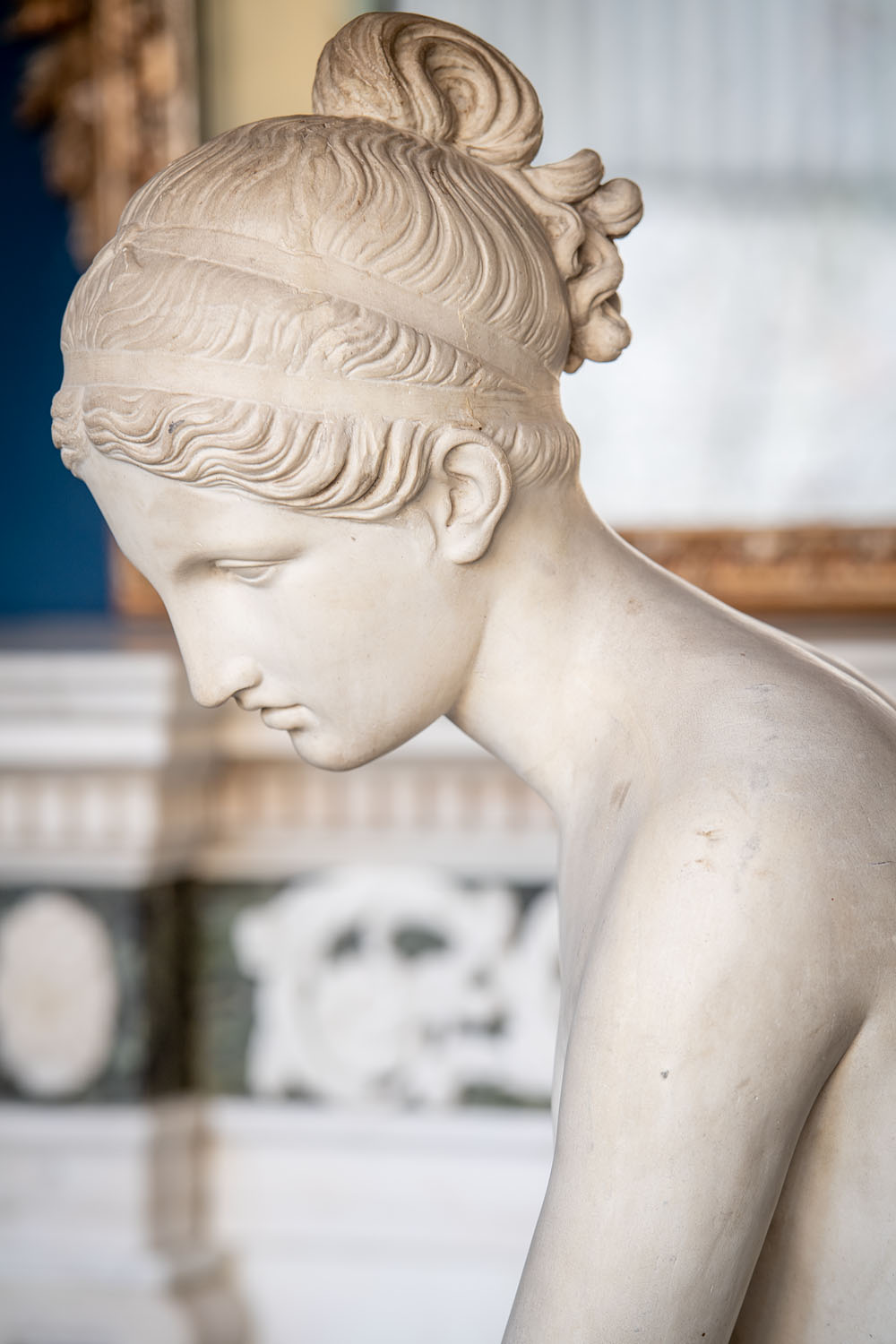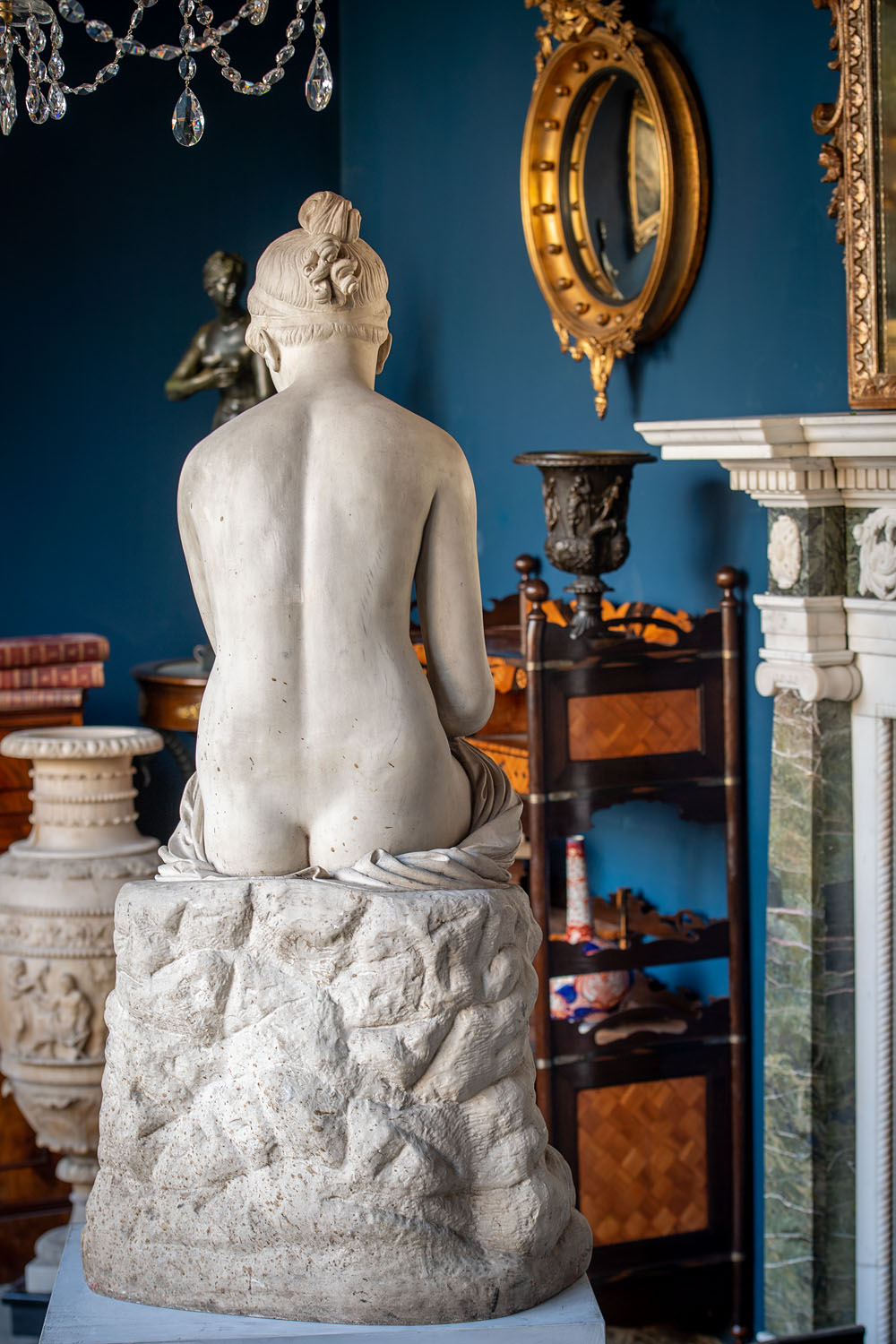02 March 2023
This month we explore an extraordinary addition to our collection, a rare Italian sculpture depicting Psyche, attributed to the Italian sculptor Pietro Tenerani.

Pietro Tenerani (1798-1869) was a sculptor perhaps best known for his neoclassical works of the early nineteenth-century. He trained under Lorenzo Bartolini at the Accademia di Belle Arti in Carrara and with his uncle Pietro Marchetti, where he learnt how to polish and finish marble. After his early training, he won a scholarship to Rome in 1815, where he entered the studio of Bertel Thorvaldsen, considered one of the great masters of the age. He worked together with Thorvaldsen on several illustrious commissions, and soon set up his own studio. Among Tenerani’s illustrious patrons were William Cavendish, 6th Duke of Devonshire, Crown Prince Ludwig of Bavaria, Queen Victoria, and Pope Pius IX.
In 1816, Tenerani produced his first model of Psyche Abandoned under his own name, a beautifully finished work in plaster. This work transcended the more rigidly neoclassical style of the period, and instead bore the naturalism of an earlier age. It was soon acquired by the noblewoman and patron of the arts Marchesa Carlotta de’ Medici Lenzoni for her private collection. The sculpture was subsequently entered into an exhibition at the Palazzo Caffarelli in Rome, where many collectors admired and praised it for its naturalism and beauty. As a result of the exhibition, some admirers of this work requested copies to be made. It is likely that our own copy of this first work was made shortly after the exhibition; it wasn’t uncommon for a much-admired work to have copies made in both plaster and in marble. Many collectors even favoured the plaster originals, understanding that in many cases the marble versions were carved by workshop assistants rather than the master. It was Antonio Canova who popularised the practice of creating a finished work in plaster, giving the work of the marble carving to his assistants. Canova would then step in at the final stages of carving, to add his own hand to the finer details.
Tenerani’s depiction of the young Psyche captured the imagination of Italian society, but the myth of the young princess and her lover had been enjoyed since antiquity. Their story is one of the interplay between the Soul and Desire. Psyche is the personification of the soul and conveys its vulnerability when met with the tempestuous and transient nature of desire, here embodied by the deity Cupid.
If Psyche and Cupid’s story concerns the soul and desire, then their ultimate union should be considered one of fate. Their story is told by Apuleius in his Metamorphoses, written in the 2nd century AD and broadly follows this narrative:
Cupid’s mother, the Goddess of love Aphrodite, was driven into a fury when she discovered that her worshippers were neglecting her and instead making offerings to a young and beautiful princess, Psyche. In her rage, Aphrodite demanded that her son Cupid make Psyche fall in love with an unworthy man as a punishment for her beauty. However, Cupid is scratched by his own arrow and falls in love with Psyche himself.
They marry, yet Cupid tells his bride to never look at him, lest she be injured if she settled her gaze on a God. She complies until one evening she can no longer resist temptation, and she casts a light over her sleeping beloved with a lamp. He wakes, and in his fury at her betrayal, flees. Psyche is inconsolable and approaches the God’s mother Aphrodite and appeals to her to reunite them. She is set a series of impossible tasks by the Goddess, and when she fails the final task, at Cupid’s request the other Gods take mercy on her, granting her immortality so the lovers can be reunited.
Apuleius’ story is a lesson about finding balance between matters of the body and spirit, in order to live in harmony. Cupid and Psyche were represented not only in this tale, but in much earlier Hellenistic Art too, which makes Tenerani the perfect master for this work.
His sculpture captures the moment in which Psyche’s beloved departs in a rage, leaving her alone. She sits on a rock, her youth emphasised in the modelling of her body and face. Her face in downcast, and her anguish is sensed not only in her expression but also in her posture. In this sculpture, Tenerani has captured the essence of the Hellenistic sculpture that he so revered at this stage of his career. Archaeological excavations in Rome had revealed ancient copies of sculptures from Greece and set the standard to which to aspire.
The drapery over her legs is reminiscent of Hellenistic sculpture insofar as it has tangible weight to it, a quality that the eighteenth-century scholar Johann Winckelmann described as a “wet look”. Carving and modelling of this quality is indicative of a master, and this detail allowed the Tenerani to showcase his skill as a sculpture independent from his master.
In this version of the sculpture, Psyche is depicted without wings. It wasn’t unusual to find Psyche represented this way, as sculptures of this quality were commissioned by or intended for an audience who would find the subject immediately recognisable. Pietro Tenerani’s first sculpture of Psyche dated to 1817 does shows her with wings and is also modelled in plaster. Both sculptures are the same size and possess an almost identical finish, where the top layer of the plaster has been toned to give it a patina, so this work is to be regarded as a finished sculpture rather than mere modello. It is perhaps most interesting to consider how the composition developed over time in the hands of its master.
Tenerani’s Psyche Abandoned is considered one of the most revered sculptures of the nineteenth-century, so we are honoured to have such a fine version in our collection.
For more information on this spectacular piece, please do not hesitate to get in touch or follow this link.



For further information on all of our latest offerings, please see here.